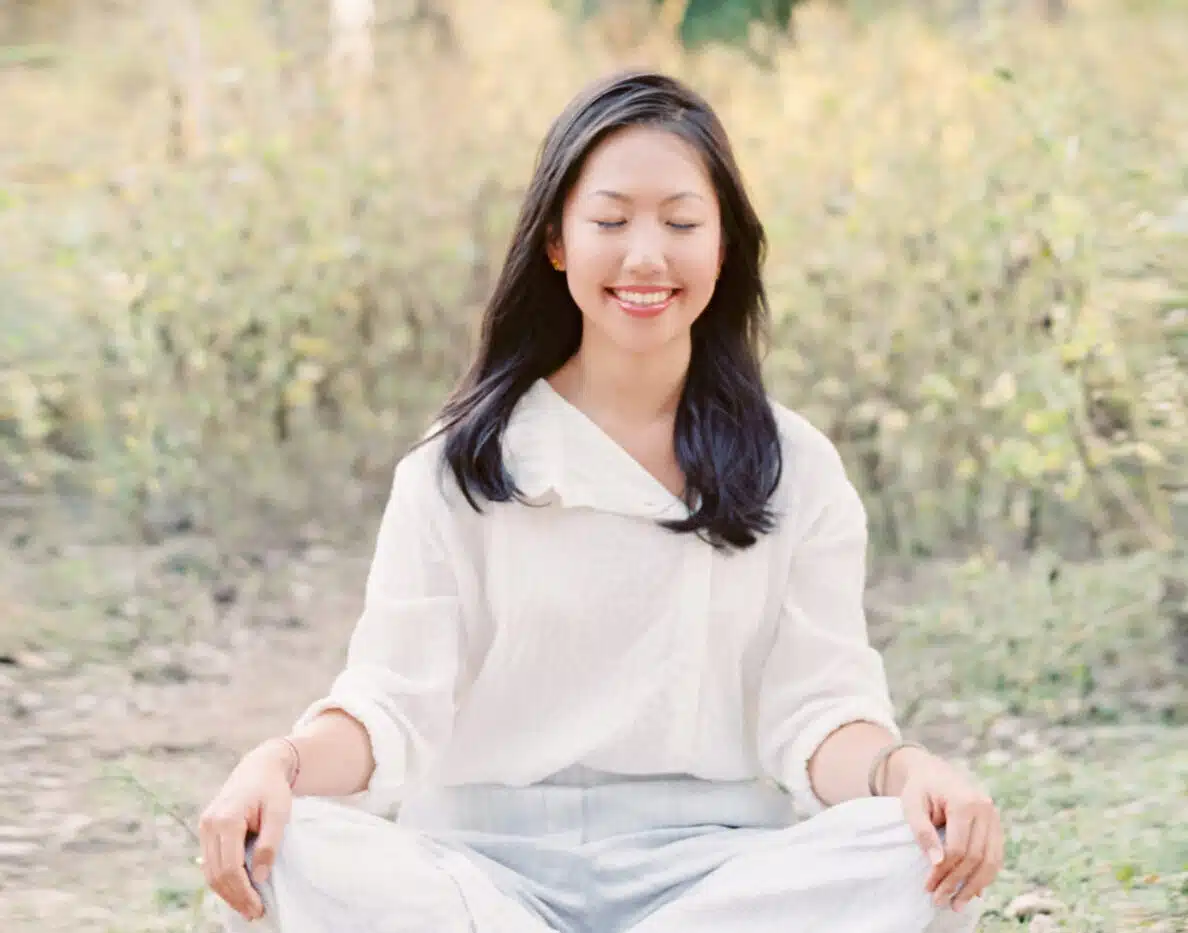How to Solve Your Problems Through Meditation
My teacher, Thom Knoles, shared a story with me about his early years as a meditation teacher. In the 1970s, he had a hand-painted, gold-embossed sign hanging outside his meditation center on Jersey Road in Sydney. For nearly a decade, this sign greeted every passerby and student who walked into his studio.
The sign at his meditation center entrance read,
“Welcome to the Solution to All Problems.”
A pretty bold statement, right?
One of Thom’s students made the sign for Thom as part of his reciprocal exchange for learning to meditate. The new meditator painted this sign to reflect his new life experience after starting to practice Vedic Meditation.
The student hadn’t discovered a magic genie to disappear all of their problems and daily demands. His life remained mostly the same after learning the practice of meditation as it was before. Something about his approach to daily demands had fundamentally changed. Somehow, he didn’t experience demands as problems anymore.
- Can we solve our problems through meditation?
- How does meditation help us solve problems in creative ways?
- Is there a way to use meditation for creativity?
In this post, we’ll discuss the two main ways Vedic Meditation helps you to solve problems: by increasing your creativity and changing your perception of problems as they arise.
Meditation and the Creative Process
Think of the last time you couldn’t remember something important. Maybe it was someone’s name or an important event date. Maybe you were trying to figure out what kind of birthday gift to give a family member, and you couldn’t think of a single thing.
Then, in the shower or while washing dishes, the answer comes to you. You remember their name. You’re on a walk and the date to that event hits you. You wake up the next morning with the perfect gift idea.
Studies show that there is an incubation period in the process of problem solving and creativity:
“The idea that a period of incubation might facilitate creativity has not only been suggested by creative minds, but has also been stressed in creativity models. Wallas (1926) proposed that the creative process entails four stages: Preparation (acquisition of knowledge to some task), Incubation (the process that occurs when conscious attention is diverted away from the task), Illumination (creative idea flashes into sight), and Verification (the creative idea is subjected to evaluation).”
– - Behavioral Science Institute
Start your Meditation Journey Today
ATTEND A FREE INTRO TALKAccording to the study, the best kinds of incubation periods for creativity were sleep and “mind wandering exercises.” The more you can tap into what they call your ‘unconscious state,’ the more creativity will be available to you.
In the Vedic Worldview, the ‘unconscious state’ is the same thing as transcendence. When we step beyond thoughts in our meditations, we access all of the knowledge stored in consciousness– all of the knowledge that exists. When we stop concentrating on the problem we want to solve and instead experience transcendence in meditation, we experience the most efficient and effective form of an incubation period. So meditation can enhance creativity in this way.
Solutions to our problems arise naturally in those final two minutes of sitting quietly with our eyes closed. It is as if a mind far greater than our own presented us with the solutions we needed, without any thinking at all.

Knowledge is Structured in Consciousness
One of Maharishi Mahesh Yogi’s favorite things to talk about was “knowledge is structured in consciousness.” Meaning we can access all knowledge when we step beyond thought and interact with Pure Consciousness in meditation. As we reach higher and higher levels of consciousness, or rather, greater oneness with the field of Being, we will access more and more of this knowledge.
Knowing that knowledge and consciousness are closely related, we can view people’s behavior in a new light. People behave and think according to their state of consciousness. They see the world through the level of knowledge that is available to them. Each person’s experience of the world is determined by their state of consciousness.
If we want to become better problem solvers or have more creativity available to us, the recommendation of the Vedic Worldview is to immerse in consciousness as much as we can. We don’t need to focus on our problems or practice ‘problem solving meditation.’ We can instead rely on our mantra to take us beyond thought. And what better way to do that than reaching transcendence in our meditation practice, twice a day for twenty minutes?
Mindfulness and Creativity
If knowledge is structured in consciousness, then we wouldn’t look to mindful thinking to gain more knowledge or solve more problems. Though being mindful may help us to feel more present, it cannot make more knowledge or more of the field of Being available to us. Creative mindfulness may include relaxing practices like making art or writing, but it does not allow us to experience an incubation period for the ideas or problems we’re working on.

Creative Ideas that are Relevant
When we forget something important or struggle to come up with a solution, it may mean that we need to take a break and let our ideas ‘incubate.’ It may also mean that the problem we’re focused on isn’t relevant to our evolution.
When we reach transcendence and access all of the knowledge that is structured in consciousness, that doesn’t mean we suddenly know everything there is to know. Consciousness delivers only the insights that are relevant to our evolution. When we can’t remember something we thought was important and we discover that it had nothing to do with our evolutionary path, we can leave it behind.
Our society values remembering all kinds of irrelevant details, from celebrity gossip to social expectations. It’s not always a bad thing to forget what’s irrelevant… even to forget to care about irrelevant things. We don’t need to be too hard on ourselves for forgetting trivial details or ideas that aren’t relevant to us. If it’s important (and we’re consistent with our meditation practice), it will arise in our consciousness and grab our attention.
Meditation for Problem Solving
We know that simply sitting down for meditation doesn’t eliminate the demands (i.e., problems) of life, whether or not they are expected or unexpected. COVID, weather disasters, power and water outages, mortgage payments – these significant events don’t simply “go away” after learning to meditate.
What does change is our responses to these demands. Stress is not triggered automatically by any particular situation.
The creation (and intensity) of a stressor is dependent on our level of interactivity with the demand.
If a change of expectation comes our way and we have the adaptation energy to interact with that demand successfully, we create waves of joy in the process. Not that we will take joy in bad news, but we’ll take joy in rising to the occasion. We’ll be interested to see how our expanding consciousness responds to the change in expectation, and we’ll see it as an opportunity to have a new experience.
On the other hand, if we do not have the rest or energy to meet that demand successfully, we have a maladaptive experience. Instead of creating bliss, we develop stress.
This is where most people spend their lives– completely depleted of adaptation energy, anxiously waiting for a change in expectation that will ‘send them over the edge.’ Something as small as a red light or a broken pen can push a person into feeling completely overwhelmed, as if the whole Universe is conspiring to make their lives harder.
Without enough adaptation energy, we want to control our environment to prevent changes in expectation. We see a lack of control or a change in expectation as a problem, rather than as a natural part of life.
So, how does meditation help us respond to demands as if they are opportunities instead of responding to demands as if they are ‘problems to solve?’
When we establish a regular habit of practicing Vedic Meditation twice daily, we:
- Release more stress than we can take on on any given day. As Vedic Meditators, we begin to enjoy life in “stress reduction mode.” Around the 5 to 8-year mark, we have successfully purified an entire lifetime’s worth of stresses from our body.
- We build up our reserve of adaptation energy and rest, which allows us to interact successfully with demands that come our way. When we feel low on adaptation energy, we replenish our reserves by sitting down to meditate.
- We transcend our thoughts and experience the Field of Being. The Field of Being, also called Pure Consciousness, is the calm, silent state of our awareness we experience in our meditation and is the home of all Knowledge. By regularly accessing this state, we begin to use our minds’ full range of creativity and harness our full mental potential.
In short, our meditations help us become better problem solvers, more creative, and experience increased resilience. Viewing demands as “problems” becomes a habit of the past, and we delight in experiencing our own capability to meet new challenges that arise.
Next time you sit to meditate, welcome yourself to your quiet, inner home where bliss, creativity, and solutions abound.
And if you are ready to solve your problems through meditation, and to establish a daily meditation practice that you’ll enjoy, click here to take the next steps and learn more.






